8.2.3: Finding Unknown Side Lengths
- Page ID
- 37745
\( \newcommand{\vecs}[1]{\overset { \scriptstyle \rightharpoonup} {\mathbf{#1}} } \)
\( \newcommand{\vecd}[1]{\overset{-\!-\!\rightharpoonup}{\vphantom{a}\smash {#1}}} \)
\( \newcommand{\id}{\mathrm{id}}\) \( \newcommand{\Span}{\mathrm{span}}\)
( \newcommand{\kernel}{\mathrm{null}\,}\) \( \newcommand{\range}{\mathrm{range}\,}\)
\( \newcommand{\RealPart}{\mathrm{Re}}\) \( \newcommand{\ImaginaryPart}{\mathrm{Im}}\)
\( \newcommand{\Argument}{\mathrm{Arg}}\) \( \newcommand{\norm}[1]{\| #1 \|}\)
\( \newcommand{\inner}[2]{\langle #1, #2 \rangle}\)
\( \newcommand{\Span}{\mathrm{span}}\)
\( \newcommand{\id}{\mathrm{id}}\)
\( \newcommand{\Span}{\mathrm{span}}\)
\( \newcommand{\kernel}{\mathrm{null}\,}\)
\( \newcommand{\range}{\mathrm{range}\,}\)
\( \newcommand{\RealPart}{\mathrm{Re}}\)
\( \newcommand{\ImaginaryPart}{\mathrm{Im}}\)
\( \newcommand{\Argument}{\mathrm{Arg}}\)
\( \newcommand{\norm}[1]{\| #1 \|}\)
\( \newcommand{\inner}[2]{\langle #1, #2 \rangle}\)
\( \newcommand{\Span}{\mathrm{span}}\) \( \newcommand{\AA}{\unicode[.8,0]{x212B}}\)
\( \newcommand{\vectorA}[1]{\vec{#1}} % arrow\)
\( \newcommand{\vectorAt}[1]{\vec{\text{#1}}} % arrow\)
\( \newcommand{\vectorB}[1]{\overset { \scriptstyle \rightharpoonup} {\mathbf{#1}} } \)
\( \newcommand{\vectorC}[1]{\textbf{#1}} \)
\( \newcommand{\vectorD}[1]{\overrightarrow{#1}} \)
\( \newcommand{\vectorDt}[1]{\overrightarrow{\text{#1}}} \)
\( \newcommand{\vectE}[1]{\overset{-\!-\!\rightharpoonup}{\vphantom{a}\smash{\mathbf {#1}}}} \)
\( \newcommand{\vecs}[1]{\overset { \scriptstyle \rightharpoonup} {\mathbf{#1}} } \)
\( \newcommand{\vecd}[1]{\overset{-\!-\!\rightharpoonup}{\vphantom{a}\smash {#1}}} \)
Lesson
Let's find missing side lengths of right triangles.
Exercise \(\PageIndex{1}\): Which One Doesn't Belong: Equations
Which one doesn't belong?
\(3^{2}+b^{2}=5^{2}\)
\(b^{2}=5^{2}-3^{2}\)
\(3^{2}+5^{2}=b^{2}\)
\(3^{2}+4^{2}=5^{2}\)
Exercise \(\PageIndex{2}\): Which One is the Hypotenuse?
Label all the hypotenuses with \(c\).
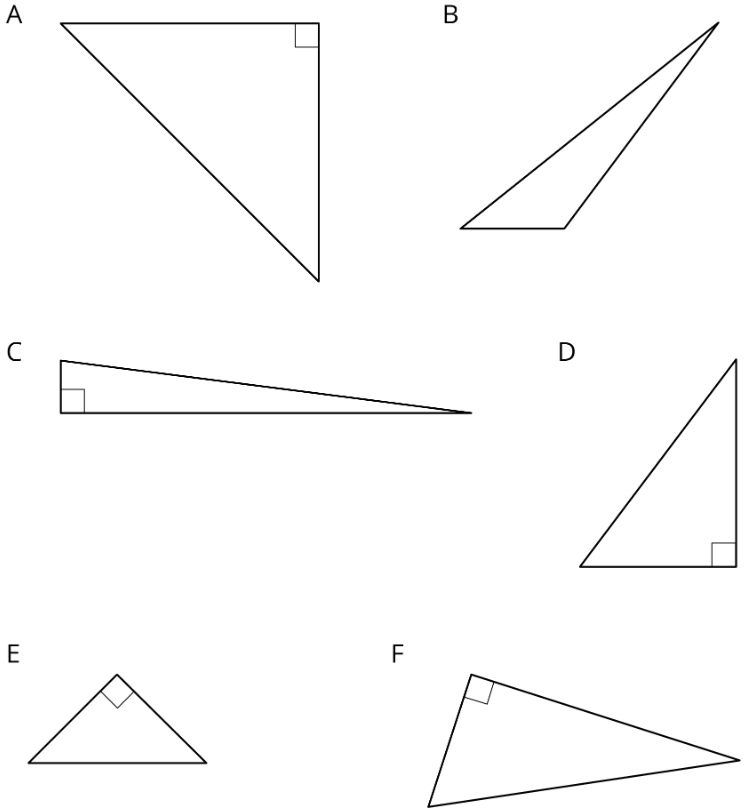
Exercise \(\PageIndex{3}\): Find the Missing Side Lengths
1. Find \(c\).
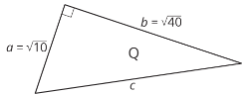
2. Find \(b\).
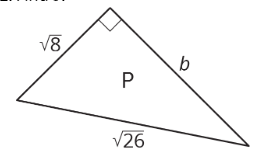
3. A right triangle has sides of length 2.4 cm and 6.5 cm. What is the length of the hypotenuse?
4. A right triangle has a side of length \(\frac{1}{4}\) and a hypotenuse of length \(\frac{1}{3}\). What is the length of the other side?
5. Find the value of \(x\) in the figure.
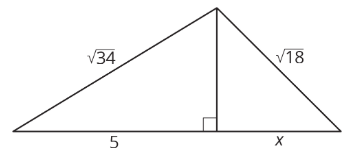
Are you ready for more?
The spiral in the figure is made by starting with a right triangle with both legs measuring one unit each. Then a second right triangle is built with one leg measuring one unit, and the other leg being the hypotenuse of the first triangle. A third right triangle is built on the second triangle’s hypotenuse, again with the other leg measuring one unit, and so on.
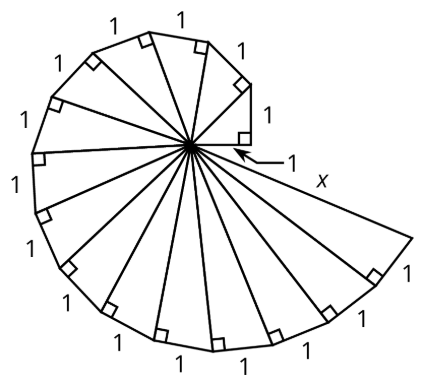
Find the length, \(x\), of the hypotenuse of the last triangle constructed in the figure.
Summary
There are many examples where the lengths of two legs of a right triangle are known and can be used to find the length of the hypotenuse with the Pythagorean Theorem. The Pythagorean Theorem can also be used if the length of the hypotenuse and one leg is known, and we want to find the length of the other leg. Here is a right triangle, where one leg has a length of 5 units, the hypotenuse has a length of 10 units, and the length of the other leg is represented by \(g\).
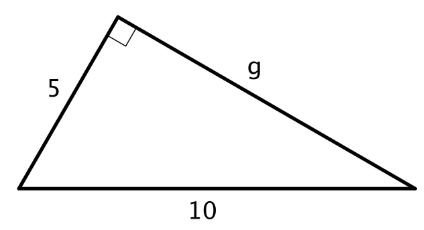
Start with \(a^{2}+b^{2}=c^{2}\), make substitutions, and solve for the unknown value. Remember that \(c\) represents the hypotenuse: the side opposite the right angle. For this triangle, the hypotenuse is 10.
\[\begin{aligned} a^{2}+b^{2}&=c^{2}\\5^{2}+g^{2}&=10^{2}\\g^{2}&=10^{2}-5^{2}\\g^{2}&=100-25\\g^{2}&=75\\g&=\sqrt{25}\end{aligned}\nonumber\]
Use estimation strategies to know that the length of the other leg is between 8 and 9 units, since 75 is between 64 and 81. A calculator with a square root function gives \(\sqrt{75}\approx 8.66\).
Glossary Entries
Definition: Pythagorean Theorem
The Pythagorean Theorem describes the relationship between the side lengths of right triangles.
The diagram shows a right triangle with squares built on each side. If we add the areas of the two small squares, we get the area of the larger square.
The square of the hypotenuse is equal to the sum of the squares of the legs. This is written as \(a^{2}+b^{2}=c^{2}\).
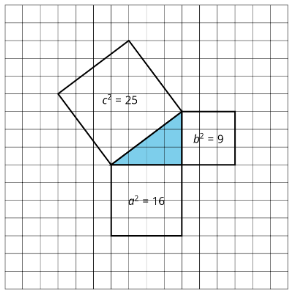
Definition: Hypotenuse
The hypotenuse is the side of a right triangle that is opposite the right angle. It is the longest side of a right triangle.
Here are some right triangles. Each hypotenuse is labeled.
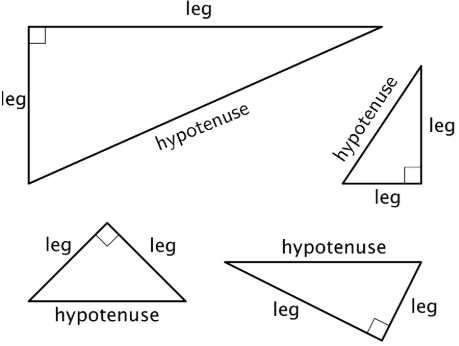
Definition: LEgs
The legs of a right triangle are the sides that make the right angle.
Here are some right triangles. Each leg is labeled.

Practice
Exercise \(\PageIndex{4}\)
Find the exact value of each variable that represents a side length in a right triangle.
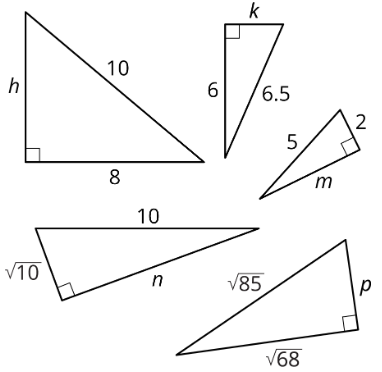
Exercise \(\PageIndex{5}\)
A right triangle has side lengths of \(a\), \(b\), and \(c\) units. The longest side has a length of \(c\) units. Complete each equation to show three relations among \(a\), \(b\), and \(c\).
- \(c^{2}=\)
- \(a^{2}=\)
- \(b^{2}=\)
(From Unit 8.2.2)
Exercise \(\PageIndex{6}\)
What is the exact length of each line segment? Explain or show your reasoning. (Each grid square represents 1 square unit.)

(From Unit 8.2.2)
Exercise \(\PageIndex{7}\)
In 2015, there were roughly \(1\times 10^{6}\) high school football players and \(2\times 10^{3}\) professional football players in the United States. About how many times more high school football players are there? Explain how you know.
(From Unit 7.3.7)
Exercise \(\PageIndex{8}\)
Evaluate:
- \(\left(\frac{1}{2}\right)^{3}\)
- \(\left(\frac{1}{2}\right)^{-3}\)
(From Unit 7.2.5)
Exercise \(\PageIndex{9}\)
Here is a scatter plot of weight vs. age for different Dobermans. The model, represented by \(y=2.45x+1.22\), is graphed with the scatter plot. Here, \(x\) represents age in weeks, and represents weight in pounds.
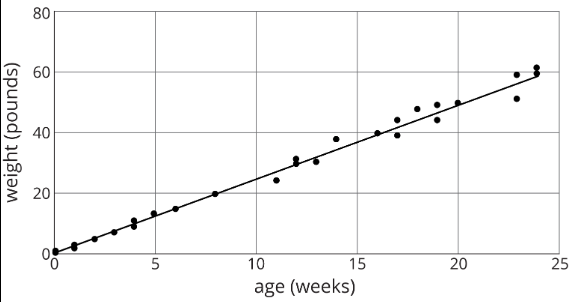
- What does the slope mean in this situation?
- Based on this model, how heavy would you expect a newborn Doberman to be?
(From Unit 6.2.4)


